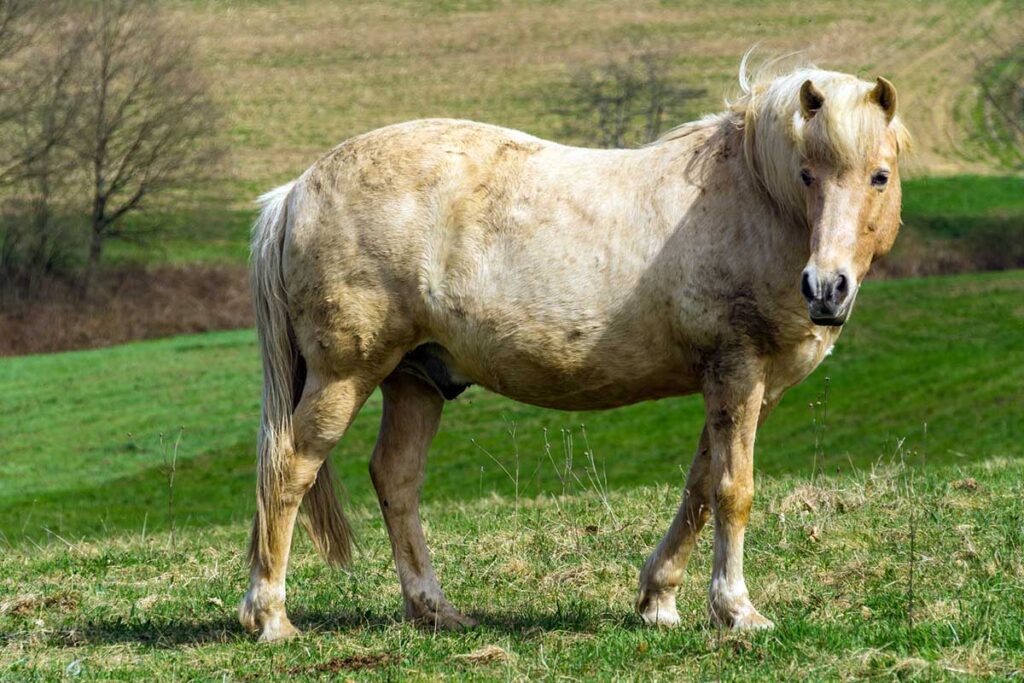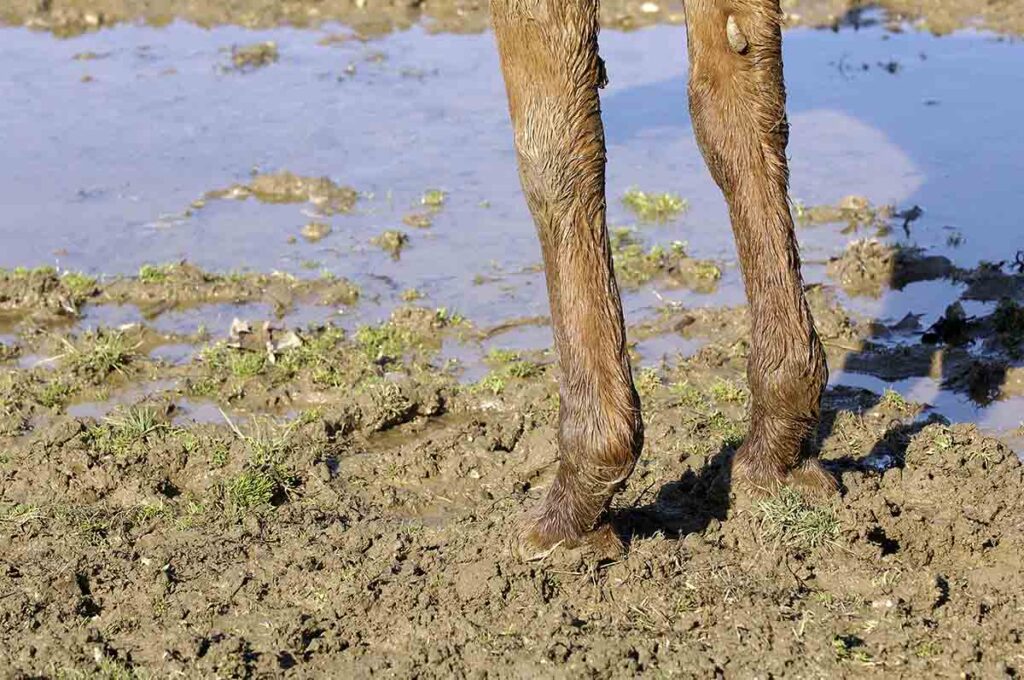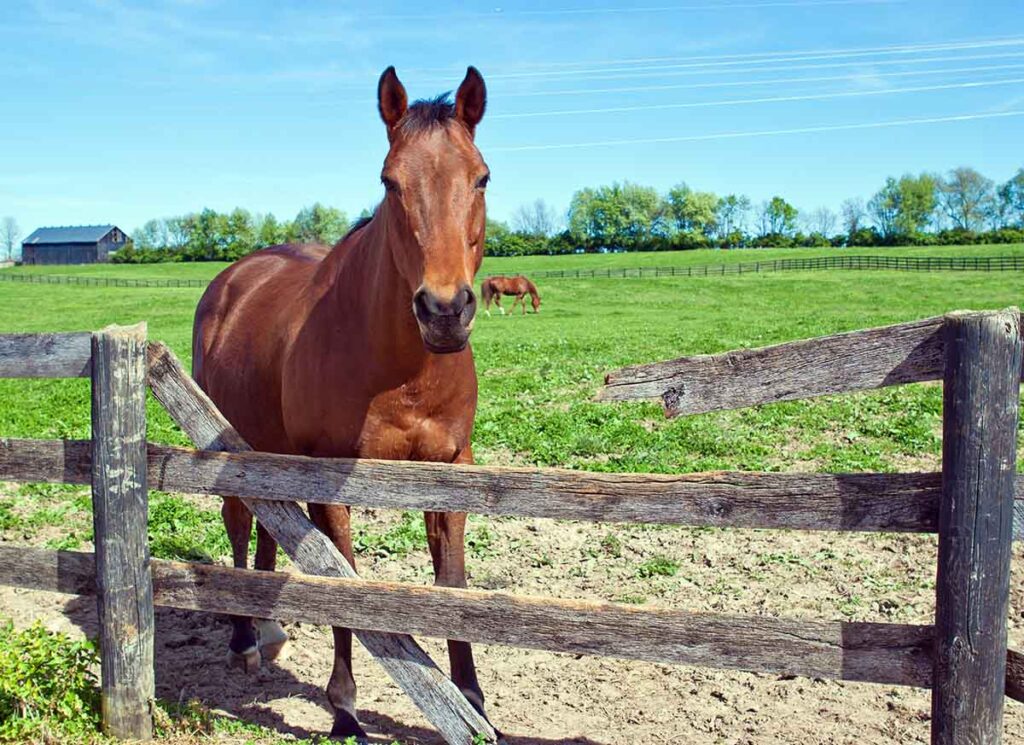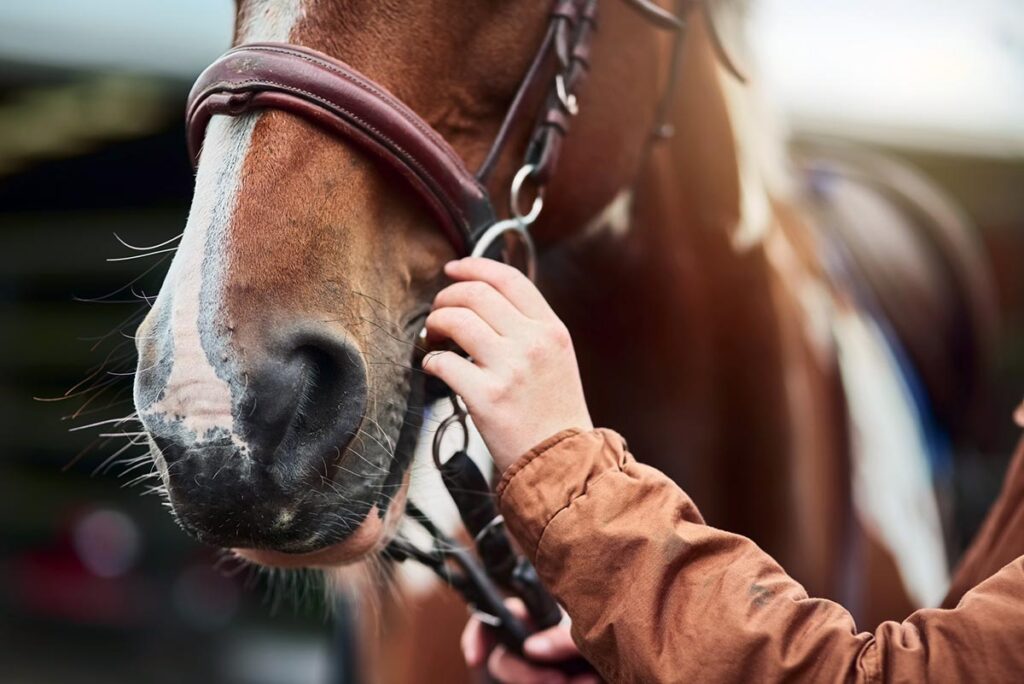Many things can go wrong with your horse’s feet—this is why it’s crucial you have a good relationship with a farrier and veterinarian. Some hoof problems, however, are more common than others. Here are eight conditions to keep an eye out for and what to do if you suspect one.
Abscess
An abscess is an infection of the sensitive tissues of the foot. An existing bruise or penetrating wound can lead to an abscess. Bacteria become trapped under the hoof wall, multiply, and form a pus pocket. The pressure can cause significant pain that persists until the pus pocket ruptures. An abscess can cause mild to severe lameness, and the hoof might feel hot to the touch. Veterinarians and farriers use hoof testers to locate the abscess so they can carefully pare away the sole and relieve the pressure. Otherwise, the pus will travel the path of least resistance and might break out at the coronary band or the heel bulbs.
Clinical signs Acute and generally non-weight-bearing lameness. The horse might point the affected foot due to the pain.
Who to call Call the veterinarian first and, if necessary, a farrier.
Immediate treatment Keep your horse in a clean, comfortable environment. Placing the foot in a hot water soak with Epsom salts or applying a medicated poultice might help relieve pain.
Once the vet/farrier arrives The veterinarian or farrier will use hoof testers to pinpoint the area of discomfort causing the lameness, then create a small hole to locate and drain the abscess from the sole-wall junction (white line). This will be followed by applying a soak bandage or a medicated poultice. He or she might also administer a tetanus booster.
Bruises
Trauma or excessive weight-bearing of the sole of the horse’s foot on hard, rocky ground usually causes bruises. Hooves that are trimmed too short can bruise easily, as well.
Clinical signs Possible lameness and a visible bruise, red spots, or specks most commonly on the sole, quarters, toe, or frog.
Who to call The farrier and the veterinarian.
Immediate treatment If you notice a problem right away, start cold therapy by soaking the foot in an ice-slurry-filled bucket to slow the blood flow and minimize bruising.
Once the vet/farrier arrives Depending on the severity, your veterinarian might prescribe non-steroidal anti-inflammatory medications and recommend special boots, shoes, or pads to prevent further damage.
Hoof Cracks

Hoof cracks are frequently caused by hoof imbalances. Horses with dry, brittle hooves or those whose feet are constantly changing from wet to dry conditions commonly develop cracks. Coronary band injuries can also be catalysts for hoof cracks. Most cracks are superficial, do not cause lameness, and grow out in time. However, if they become deep and reach the hoof’s sensitive tissues, they can cause considerable pain and require more intensive care.
Clinical signs A vertical (or, rarely, horizontal) crack at the horse’s toe, quarter, heel, or bar.
Who to call If there’s no blood and your horse shows no signs of discomfort, then call your farrier.
Immediate treatment Clean the foot and keep it covered (using a hoof boot or gauze/wrap/duct tape combo) until the farrier arrives.
Once the vet/farrier arrives Your farrier will need to determine the cause of the crack and respond appropriately. He or she might need to repair the crack to stabilize it, protect the damaged wall, eliminate pain/bleeding, and prevent further progression and possible infection.
Hot/Close/Quicked Nail
This occurs when a farrier shoes a horse and drives a nail too close to the sensitive tissues.
Clinical signs Non-weight-bearing lameness occurs immediately following shoeing. Your horse might point his toe to take pressure off the painful area, and there might be a trace of blood where the nail exits the hoof wall.
Who to call Call the farrier or, if severe, a veterinarian.
Immediate treatment Do not remove the nail, but restrict your horse’s movement and keep him comfortable in a stall.
Once the vet/farrier arrives Have your farrier or veterinarian remove the hot nail immediately and treat any infection in the area. Once the nail is removed, establish drainage. This might be followed by applying and maintaining a soak bandage or medicated poultice until any infection subsides. To be safe, your veterinarian might administer a tetanus booster.
Laminitis

Laminitis is an extremely painful hoof disease in which the tiny tissues called lamellae that attach the horse’s hoof to the coffin bone within it fail, potentially causing the bone to sink or rotate within the hoof capsule. It can have many causes, including metabolic disease, toxins in the bloodstream, and compensation for injury to the opposite limb.
Clinical signs Reluctance to walk, weight shifting, a “sawhorse” or “pointing” stance, or more time than usual spent lying down. Always consider so-called bruising to be laminitis until proven wrong.
Who to call The veterinarian and, later, a farrier.
Immediate treatment Begin cryotherapy (e.g., standing in an ice slurry that extends above the fetlock, or ankle) immediately, restrict your horse’s movement, and place him on soft footing/deep bedding.
Once the vet/farrier arrives Your veterinarian might take radiographs, prescribe pain-relief methods, and work with your farrier to stabilize the horse’s feet initially.
Possible Fracture
The coffin bone within the horse’s foot can fracture for any number of reasons and can be a serious injury.
Clinical signs Sudden lameness (particularly after exertion), increased pulse in the arteries at the back of the fetlock/ankle, swelling, among others. Owners sometimes mistake it for a bruise.
Who to call The veterinarian and, later, a farrier.
Immediate treatment Get your horse into a clean, deeply bedded stall and restrict movement.
Once the vet/farrier arrives Veterinarians use radiographs to confirm a fracture. As fractures often don’t show up on radiographs for three to five days, more advanced diagnostic imaging methods, such as MRI, can be used to confirm foot fractures. Depending on the location and severity, horses require stall rest, therapeutic shoeing, casting, or even surgical repair.
Puncture Wound

Nails, fence staples, stiff pieces of wire, pieces of metal, and more can penetrate the bottom of your horse’s foot.
Clinical signs Lameness ranging from mild to severe, an observable puncture site in the bottom of the foot, signs of infection, and possibly, the penetrating object still in place.
Who to call The veterinarian.
Immediate treatment If the offending object, especially a nail, is still in the horse’s foot, do not remove it. The veterinarian will want to take a radiograph with the object in place to determine its depth, direction, and what structures might be involved. Restrict your horse’s activity, protect the wound to prevent further trauma, and keep him as comfortable as possible— preferably in a clean, deeply bedded stall.
Once the vet/farrier arrives If the wound is not serious, the veterinarian will clean, explore, lavage, debride, and bandage the area as well as administer a tetanus booster and antibiotics if needed. In more complicated cases radiography is necessary to reveal the direction and depth of the puncture and structures involved and to determine next treatment steps.
Thrush
This bacterial infection of the frog and/or its clefts occurs due to wet conditions, poor foot circulation, poor hoof conformation, insufficient exercise, chronic lameness, and more.
Clinical signs Black, decaying material with a foul odor in and around the horse’s frog. Most horses with mild cases of thrush are not lame, but if the infection is severe and invades the sensitive layers of the foot, then cleaning and manipulating the frog can cause a painful response.
Who to call If mild, your farrier.
Immediate treatment Pick your horse’s feet and keep them dry.
Once the vet/farrier arrives Your farrier might trim away the dead, infected tissue and recommend a medicated thrush product for daily use. Severe cases could benefit from your veterinarian administering systemic antibiotics and your farrier performing corrective trimming and shoeing.
Take-Home Message
When it comes to equine hoof health, every step matters. These complex structures bear your horse’s entire weight and play a critical role in his overall health and performance. By recognizing the signs of problems ranging from minor infections to serious fractures, you can take action and get the appropriate help so your horse can return to soundness as soon as possible.








